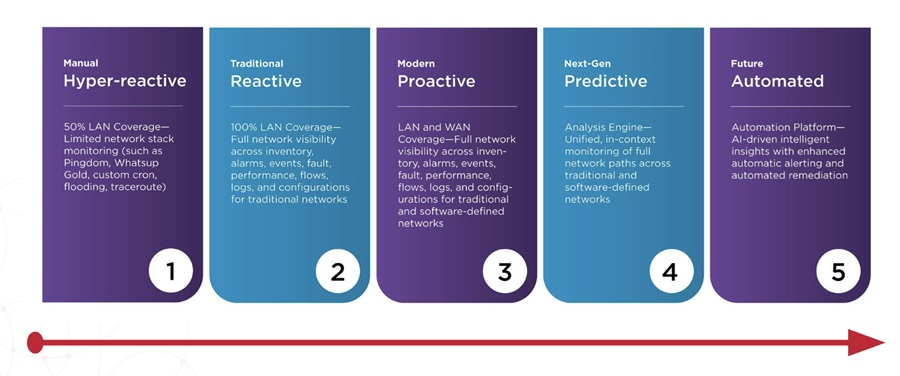With the NBA All-Star game just ahead and the NHL game just behind, it made me consider the All-Stars of Application Monitoring — Automation and Artificial Intelligence (AI).
Automation is the workhorse that does all the little things: In basketball terms, that means rebounding and setting screens. For hockey, that's killing penalties and floor-checking.
For APM, "Automation" supports tasks like Discovery, Setup, Configuration, Reporting.
Then there's the superstar playmaker — the player that sees the whole field of play, understands what will happen beforehand and places resources in the right position to make the winning plays. For the new generation of APM, that's AI.
AI sees everything; analyzes everything. AI recognizes strengths and weaknesses. AI sees events and problems before they actually occur and takes actions as needed to address the situation.
A Brave New World
Today's digitally transformed organizations have embraced Agile and DevOps to help them quickly and efficiently deploy dynamic applications using containers and microservice architectures. Developing applications at an increasingly rapid pace with these new technologies helps businesses succeed, but it adds tremendous complexity to the application and IT environments.
Automation and AI technologies are critical to the next step in APM evolution
Operations teams can no longer manually monitor and manage today's applications due to their dynamic and complex nature, as well as the speed of development and deployment. APM had to evolve to keep pace with development velocity and maintain the service quality for the modern applications born out of digital transformation.
Automation and artificial intelligence (AI) technologies are critical to the next step in APM evolution, helping to address speed, scalability and intelligence demands.
Automation and AI are Better Together
On basketball and hockey teams, when each star does their job together with their teammates, it's a winning combination. APM is no different when AI and Automation get together. Unlike a sports team, though, "losing a game" for APM owners can be catastrophic.
Today's businesses ARE their applications. If an application isn't running well, users (employees, partners, or customers) are unhappy and the business suffers. If an application completely breaks, it can severely impact the bottom line.
For APM to work, it needs more than data. It needs actionable information to analyze and manage application performance.
Early APM tools did pretty well managing applications that were 3-tiered monoliths or SOA-based. But with the growth of cloud, microservices and containers, monitoring and managing today's applications requires increased speed, scalability and intelligence.
Unfortunately, the development velocity (approaching continuous delivery) and application complexity make it impossible for humans (even experts) to analyze all the necessary information and take appropriate actions to keep applications performing properly.
Enter the two new APM all-stars — AI and Automation — the only way for any organization to regain control over their complex applications. Why are both of these great concepts required, and required to work together?
1. To match the speed and scalability of the modern dynamic applications
2. To analyze the massive amounts of data gathered and measured from each application
3. To take appropriate actions to adjust the infrastructure, platform or microservices to ensure the application performs as needed
Proper automation sets the stage for AI to analyze and act on application performance through:
■ Continuous discovery and mapping: Proper application of AI requires completely accurate data, especially dependency information. Otherwise, you're wasting time analyzing bad data. With automated, continuous discovery, application maps are always accurate and always reflect reality.
To deliver actionable information, AI has to start with Hi-Fidelity data
■ Hi-Fidelity data: To deliver actionable information, AI has to start with Hi-Fidelity data. After automatically discovering the components and mapping the application, monitoring can begin. But the information must be in real-time. As fast as applications change, operations teams need to those updates — in one second or less. This ensures AI is applied to the most accurate data possible.
■ A full stack application model: Because true AI can only operate with the deepest visibility, understanding the dependencies and configurations among the physical and logical components — in real-time — is critical.
■ Accommodating container and microservice fluidity: Modern applications are in constant change, are deployed in hybrid environments and will likely include multiple programming languages, middleware and databases, especially if using microservices. Automated discovery with zero configuration will help operations keep pace with development teams and application change.
With automation providing up-to-the-second, high-quality data; a full understanding of the application component dependencies; and the ability to handle modern development and deployment paradigms such as microservices and containers, AI confidently can be engaged to provide:
■ Real-time, AI-driven incident monitoring and prediction: DevOps teams need accurate and actionable information within seconds after change occurs. That type of information also is invaluable when a performance problem is imminent. Applying real-time AI to the monitoring data, which is coming in real-time, delivers analysis and performance insights in less than three seconds.
■ AI-powered troubleshooting and resolution: Modern applications are simply too complex for humans to effectively manage on their own. Because of the dynamic nature of their structure, their complex dependencies and the sheer scale, machines learning and AI must be applied. The application intelligence generated provides a baseline for problem prediction and resolution.
Automation and AI working together (and operating in seconds, not minutes) are the core components for managing modern applications. They can combine to create a democratized APM solution capable of handling the speed, scalability and intelligence that today's dynamic applications require.


